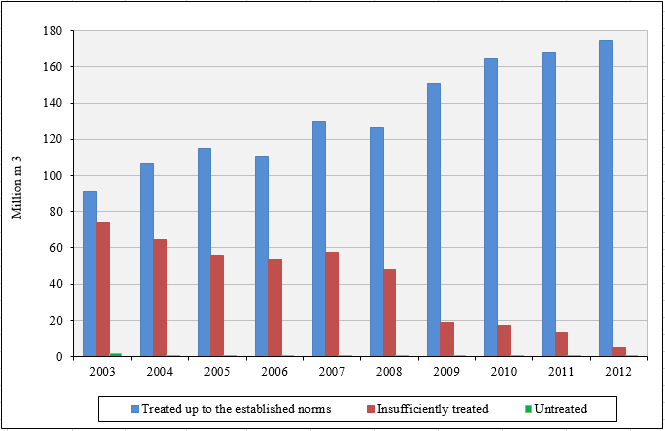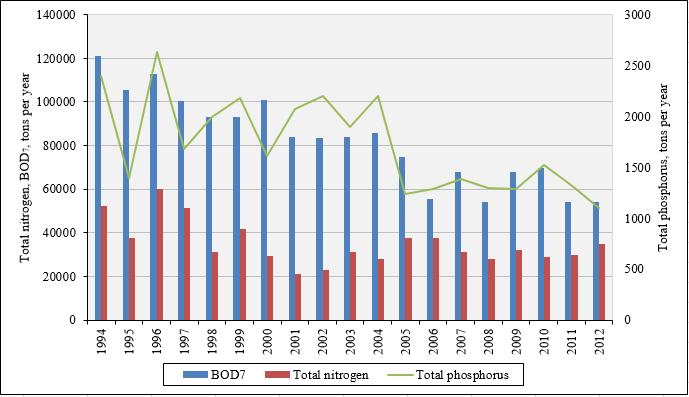Main themes and sectors addressed in the national State of Environment report
Reports on the state of the environment according to Driving Forces-Pressures-State-Impacts-Responses (DPSIR) framework in Lithuania have been published since 2001. Since 2006, the Environmental Protection Agency (EPA) publishes "State of the Environment. Only Facts" publication on an annual basis. It briefly discusses the most pressing environmental issues in Lithuania, using interrelated groups of about 85 indicators. The following topics are reflected in the latest SOER[1] (published in 2013):
- overview of the key elements of climate change;
- key changes in air emissions, ambient air quality and progress in use of renewable energy resources;
- quality of water and wastewater;
- waste sector overview;
- status of biodiversity, landscape and protected areas; and
- environmental impact assessment, economic pollution prevention measures and environmental accidents.
Since 2008 every five years a more thorough publication, "Lithuania's Environment: State, Processes and Trends", is issued, which is designed not only to review changes in the environment, but to analyse the reasons for these changes, the main environmental achievements and challenges, as well as presenting possible scenarios for the selected environment sectors in the near future[2].
Key findings of the State of Environment report
Lithuania managed to achieve GDP growth faster than growth in greenhouse gas (GHG) emissions, implementing the European Union's (EU) Sustainable Development Strategy.
Annual GHG emissions in Lithuania amount to 4-5 tons per capita and are among the lowest in the EU[2]. Total GHG emissions in 2012 were 55.6% below base-year (1990) levels. However, the energy sector remains a major source of GHG emissions (61.7% in 2010), as well as agriculture (21.4%), industry (10.8%), waste sector (up to 5.6%)[2]. In 2012, the energy produced from renewable sources amounted to 17.3% of primary energy and has doubled over a decade.
In 2012, the annual average concentrations of major air pollutants in urban areas did not exceed the limit values. The amount of main air emissions in 2011 fell by 7%, compared to the previous year. This indicates a successful implementation of cleaner technologies in industry. However, benzo(a)pyrene concentration in ambient air is increasing and it is partly associated with the increasing use of biofuels in energy companies and households[1].
Wastewater quality after treatment is rapidly improving. In 2012, up to 97% of wastewater from households and industry has been cleaned to the standards (Fig.1). An increase in the efficiency of wastewater treatment plants led to a stipulated reduction of the quantity of pollutants by 14% in 2012 compared to 2011. In 2012, the pollution load from wastewater discharges from all cities and settlements with a population greater than 2 000 was significantly (23-45%) lower than in the period 2008–2009[1].

Source: Environmental Protection Agency
Effective wastewater treatment has a positive effect on surface water bodies, and particularly on the largest Lithuanian inland water body. The ecosystems of the Lagoon are highly dependent on the input of pollutants from rivers. During the period 1994–2012, downward trends were apparent for phosphorus and BOD7. The most significant drop in pollutant concentrations was observed during the period 2004–2005, following the modernisation and expansion of wastewater treatment facilities. In 2012, compared with 2011, phosphorus inflow into the Lagoon and BOD7 decreased by 12%. The total nitrogen inflow since 1998 has no clearer trend, as a large part of this consists of diffuse pollution from agriculture, which is more complicated to control[2] (Fig.2).
In 2011, the 78% of municipal waste was disposed of in landfills, reaching 434 kg per capita. Comparing with 2010, the use and export of municipal waste has increased by 50%, but the largest share of it (76%) consists of scrap metal, which usually does not arrive in landfills. Collection of industrial waste per unit of GDP is declining since 2004, with only a slight increase during the economic slump (2009-2010), followed by a clear decrease in 2011, falling below the pre-crisis level[1].

Source: Environmental Protection Agency
Main policy responses to key environmental challenges and concerns
Lithuania has continued to contribute with efforts to solve global climate issues. In order to foster further reduction of the GHG emissions, several resolutions were adopted during the period 2010-2012:
- National Strategy for Climate Change Management Policy[3], establishing the national target to lower GHG emissions by 15% (compared to 2005, non-trade sector) until 2020. This goal was supported in 2013 by the Inter-institutional Action Plan for the Implementation of the National Climate Change Management Policy Strategy 2013-2020[4];
- National Strategy for the Development of Renewable Energy Resources[5], aiming to increase final energy consumption from renewable energy resources by at least 23% until 2020;
- National Energy Independence Strategy[6], indicating the key initiatives for the energy sector stability in the future: the regional Visaginas nuclear power plant construction, renewable energy use development and increasing of energy use efficiency.
In order to improve the water bodies management and protection system, safeguarding more sustainable use of water resources, protection of the good status of water bodies and water quality assurance, in 2012 the Government of the Republic of Lithuania adopted list of measures[7]. This included the preparation of Nemunas, Venta, Lielupė and Dauguva river basin districts management plans and establishing programmes to achieve the water protection objectives for the period 2016-2021, development and installation of the system of flood monitoring, evaluation and risk management.
In order to comply with the HELCOM Baltic Sea Action Plan and Marine Strategy Framework Directive, the Baltic Sea Environment Protection Strategy[8] was approved, which aims to achieve and maintain good environmental status of the Baltic Sea until 2020. The main objectives include further development of environmental management, reduction of the nutrients flow, reduction of pollution by dangerous substances and their impact mitigation, biodiversity conservation, reduction of adverse impacts from navigation and other economic activities. To ensure implementation of the objectives of the Strategy, the Action Plan for the Baltic Sea Environment Protection Strategy for 2010-2015 was approved[9].
In 2011, a large part of municipal waste continued to be disposed of in landfills. Each year growing use of recycled waste has led to a decrease of about 2-3% in the waste disposed of in landfills. If, as expected, more municipal waste incineration plants are created then the amount of waste disposed to landfills might be reduced up to 10-15%.
In 2012, the amendment of the Law on Waste Management[10] was passed in order to improve the management of municipal waste regulation. To foster prevention of pollution and waste in forests, parks and residential areas, environmental damage compensation rates were increased up to 10 times. The National Waste Prevention Programme 2014-2020[11] was adopted to promote sustainable consumption, rational use of resources and materials. This was then followed by the National Waste Management Plan for 2014-2020[12], which described waste management goals, objectives and measures, as well as guidelines for national and EU funding support for the sector.
In recent years, the number of extreme environmental incidents have declined to 1-2 incidents/year, while economic output has risen. In 2012, 19 decisions on proposed economic activity were adopted with none rejected. This could be associated with a decline in the number of potentially environmentally hazardous economic facilities and adequate operational control[1].
Country specific issues
Point source water pollution was significantly reduced by constructing new modern urban wastewater treatment facilities and reconstructing the outdated ones, but the impact of diffuse pollution on surface water bodies still remains an issue.
Since 2013 damage to the environment (including biodiversity) would result in a stringent (tenfold) fine being applied. Data show that, e.g., coarse fishing offenses, compared with 2012, have decreased threefold. To ensure a decrease in environmental damage actions are underway to modernise the environmental supervision system.
After a preliminary flood risk assessment, flood hazard and risk maps have been prepared. They concentrate on evaluating areas which could be flooded by rivers or sea in coastal areas, and assess the potential flood-related adverse consequences for human health, environment, cultural heritage and economic activity.
In 2012, the University of Yale declared Lithuania as the country with the best forest protection and management system in the world, over a 15 year period. To maintain such a rating, challenges remain to ensure the sustainable use of forest resources.
Document Actions
Share with others